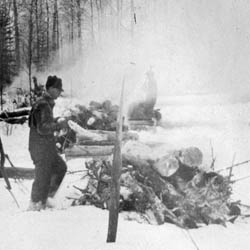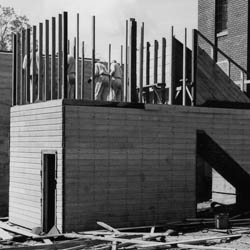Most of the images in this exhibition depict voluntary labour - labour for which the worker is voluntarily providing his or her time and skills to an employer for wages and benefits that both agree to accept. In practice many wages and conditions of work are determined by collective agreements and by the labour, health and human rights legislation enacted by governments. The images on this page and others in the Mandatory Labour gallery depict labour under conditions far more restricted and for which there was no or very little opportunity to decline.
In his book Park Prisoners: The Untold Story Of Western Canada's National Parks, 1914-1946 historian Bill Waiser writes of the lives and labour of the over 10,000 men interned in camps in Canadian national parks, including Saskatchewan's own Prince Albert National Park. The first of four groups set to mandatory work were 'enemy aliens.' When World War I was declared in August 1914 there were many landed immigrants in Western Canada who had retained the citizenship of now enemy states including those of German, Polish, Hungarian, and Ukrainian backgrounds. Under the provisions of the War Measures Act (1914), 8,579 enemy aliens were interned in remote prisoner of war camps and used as military conscript labour.
During World War II fewer of this type of domestic enemy alien were interned. However alternative service camps were established in the parks for conscientious objectors, frequently Mennonites and Jehovah's Witnesses. The parks also provided the location for work camps for Japanese-Canadian evacuees and captured German prisoners of war.
During the Great Depression thousands of single young men left their homes to reduce the economic burden on their families and to search for paid work, which was virtually non-existent. The provincial and federal governments did contribute some funding for municipal make-work relief projects including the construction of bridges in Saskatoon and Regina. Employment on the Broadway Bridge in Saskatoon was restricted to married men who received 45 cents per hour. The hours of work available to each worker were determined by the number of his dependents.
Work camps for roving unemployed single men were eventually established, but only at a distance from cities by the Conservative government of R.B. Bennett. Some men were sent to Prince Albert National Park to work on roads and other park improvements. A large work camp was created at Dundurn, south of Saskatoon, which eventually housed close to 2,000 men. These 'royal twenty-centers,' as they called themselves with reference to their daily wages, were provided with army rations and tobacco, and generally forced to work six and a half days a week.
The Dundurn camp was the site of considerable strife, including protests and a strike beginning on December 12, 1935. Angry and dissatisfied workers described these new facilities as slave camps.
Inmates of Saskatchewan prisons and jails are often assigned work duties. This labour assists in the upkeep and operation of the institutions and helps to fill part of the inmates' days. Various rationales have been proffered for penal labour programs. Some believe they have a rehabilitative role in encouraging discipline, responsibility, and the development of self esteem and social skills. Archival photographs indicate that vocational training in Saskatchewan jails and prisons has included farming, cooking, shoe and small appliance repair. Much of the public sees work as a sign of good citizenship and there is pressure to ensure that jailed criminals are not seen as enjoying a soft and leisurely life at the government's expense.
Mental health patients at the Saskatchewan Hospitals in North Battleford (est. 1913) and at Weyburn (est. 1921) were also assigned labour in the belief that work had therapeutic value in providing lives with meaning. The grounds of both facilities were developed as beauty spots through the work of patients. Native children at some Indian residential schools were also assigned daily manual work, sometimes to support the operation of the institution.




![Pouring Concrete, ['1932']](cropthumbs/BroadwayBridge-70.jpg)



![Saskatchewan Hospital Ironing Room, ['ca. 1931']](cropthumbs/R-A9164.jpg)